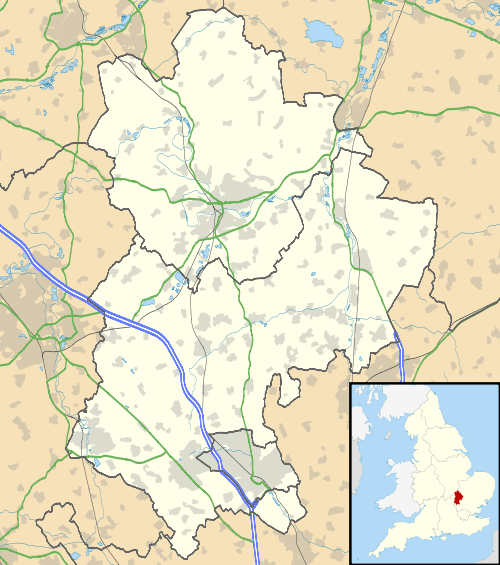Marston Moreteyne
| Marston Moreteyne | |
|---|---|
|
Parish church of St Mary | |
 Marston Moreteyne Marston Moreteyne shown within Bedfordshire | |
| Population |
4,556 (2011) census including Lower Shelton and Upper Shelton [1] |
| OS grid reference | SP995424 |
| Civil parish |
|
| Unitary authority | |
| Ceremonial county | |
| Region | |
| Country | England |
| Sovereign state | United Kingdom |
| Post town | Bedford |
| Postcode district | MK43 |
| Dialling code | 01234 |
| Police | Bedfordshire |
| Fire | Bedfordshire and Luton |
| Ambulance | East of England |
| EU Parliament | East of England |
| UK Parliament | |
Marston Moreteyne (or Marston Moretaine[2]) is a large village and civil parish located on the A421 between Bedford and Milton Keynes. It has a population of 4,560,[3] and is served by Millbrook railway station, which is about a mile away, on the Marston Vale Line. The population at the 2011 Census had decreased marginally to 4,556.[1]
On the outskirts of the village sits the Forest Centre and Millennium Country Park in the heart of the Forest of Marston Vale. The village now has several shops, post office, Co-op store, Ingle and Caves Family Butchers, one public house (The Bell), fish & chip shop, doctor's surgery, an Indian restaurant and two Lower schools, across the main village and the adjoining hamlets of Upper Shelton, Lower Shelton and Wood End along with a small local art gallery/dealer: New Urban Art.
Sir Thomas Snagge lived in the village in the 16th century. He owned the manor of Marston Moreteyne.[4]
Future development
Marston Park was allocated in the Mid Bedfordshire Local Plan for an extension to the village of Marston Moretaine with a mix of land uses. In 2008, the developers O&H Properties gained outline planning permission for 480 new houses, three hectares of employment land for offices, a new local centre, a primary school, a community building and a sports ground with cricket field. David Lock Associates were then commissioned to produce a Design Code to guide the development, and this was approved by Central Bedfordshire Council in 2010. David Wilson Homes, Barratt Homes and Bovis Homes have begun building the houses and the community building, and have created play areas. The land allocated for employment and a local centre are currently reported to be for sale.
St Mary's Church
Dating from around 1340, the church of St Mary the Virgin is a 14th-century church with a very rare feature for the East of England, a Grade I listed detached tower to the north of the church located about 70 feet from the north wall of the chancel. Grade I listing denotes that the building is of outstanding or national architectural or historic interest.
According to legend, the church's detached tower is the work of the Devil, who was trying to steal it. Finding it too heavy, he dropped it where it still remains.[5]
Notable residents
- Thomas Snagge (1536–1593), Speaker of the House of Commons, was lord of the manor of Marston Moretaine and his tomb is in the parish church[6]
- James Smith (died 1667), poet, was a native of the village[7]
- Edward Tylecote (1849–1938), cricketer, was born in the village
- James Inkersole (died 1827), lost an arm at the Battle of Waterloo[8]
Gallery
- St Mary The Virgin March 2007
- St Mary The Virgin March 2007
References
- 1 2 "Civil Parish population 2011". Neighbourhood Statistics. Office for National Statistics. Retrieved 10 November 2016.
- ↑ "The Forest of Marston Vale Trust - Home". The Forest of Marston Vale Trust.
- ↑ Office for National Statistics: Census 2001 : Parish Headcounts : Mid Bedfordshire Archived 26 May 2013 at the Wayback Machine. Retrieved 16 October 2010
- ↑ A History of Moreteyne Manor - Moreteyne Manor website, Accessed 03-01-2009
- ↑ Ash, Russell (1973). Folklore, Myths and Legends of Britain. Reader's Digest Association Limited. p. 271. ISBN 9780340165973.
- ↑ P. W. Handler, The House of Commons, 1558-1603: Members, M-Z (1981), p. 410
- ↑ Timothy Raylor, Cavaliers, Clubs, and Literary Culture (1994), p. 50: "James Smith was baptized at Marston Moretaine, Bedfordshire, on 25 July 1605. His father, Thomas Smith, was parson of Marston and a man of some means."
- ↑ Monumental inscriptions Archived 15 July 2015 at the Wayback Machine. at bedfordshire.gov.uk, accessed 15 July 2015
External links
| Wikimedia Commons has media related to Marston Moretaine. |